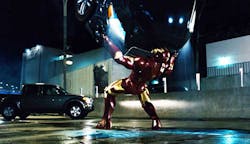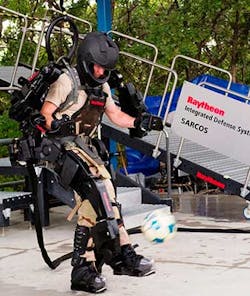When we've covered exoskeletons in the past, the stories always come with the caveat that these wearable machines will modestly ease your physical tasks. They won’t give you extra powers. They won't turn you into Iron Man (or Woman). New models coming out in a little more than a year, Sarcos Robotics' Guardian XO and XO Max, are about to change all that.
"It gives a human super human strength," affirms Ben Wolff, CEO of Sarcos. "You're able to lift a couple hundred pounds repeatedly over an eight-hour session without breaking a sweat. There's no stress or strain on the body at all."
The payload capacity for the XO is 80 lb. and the XO Max allows wearers to lift 200 lb. Testing has shown strength can be amplified by 20 times, so 100 lb. feels like 5 lb. There have been nine different prototypes and 17 years of work to get to this point.
A breakthrough in energy usage allows these lustrous, canary yellow exoskeletons to use less than 400 W while walking at human speed. That's not even 10% of a what a typical humanoid robot would consume, Sarcos says.
Battery life for the XO is four hours and eight for the XO Max, with battery hot swaps able to be performed in a few seconds. Wolff says five years ago, they got 20 minutes of power. This innovation, paired with the inflexibility of industrial robots, at least gives humans a fighting chance in the coming age of automation.
When we've covered exoskeletons in the past, the stories always come with the caveat that these wearable machines will modestly ease your physical tasks. They won’t give you extra powers. They won't turn you into Iron Man (or Woman). New models coming out in a little more than a year, Sarcos Robotics' Guardian XO and XO Max, are about to change all that.
"It gives a human super human strength," affirms Ben Wolff, CEO of Sarcos. "You're able to lift a couple hundred pounds repeatedly over an eight-hour session without breaking a sweat. There's no stress or strain on the body at all."
The payload capacity for the XO is 80 lb. and the XO Max allows wearers to lift 200 lb. Testing has shown strength can be amplified by 20 times, so 100 lb. feels like 5 lb. There have been nine different prototypes and 17 years of work to get to this point.
A breakthrough in energy usage allows these lustrous, canary yellow exoskeletons to use less than 400 W while walking at human speed. That's not even 10% of a what a typical humanoid robot would consume, Sarcos says.
Battery life for the XO is four hours and eight for the XO Max, with battery hot swaps able to be performed in a few seconds. Wolff says five years ago, they got 20 minutes of power. This innovation, paired with the inflexibility of industrial robots, at least gives humans a fighting chance in the coming age of automation.
ADVERTISING
"There are complicated, repetitive tasks that just can’t be automated," Wolff says. "Because of the variation in them, there's always a need to have humans involved in getting the task done."
Humans are just more agile and able to adapt. It's how we shot to the top of the food chain despite being weak, hairless primates. Just look at past DARPA challenges to see the limitations of even the most advanced humanoid robots.
And for as jaw-dropping as Boston Dynamics' Atlas and Spot Mini are, backflipping and barely being able to open a door aren't skills that translate to the factory floor. As for Artificial Intelligence, it has its uses, but is nowhere close to behaving as intelligently as even your least cognitively gifted employees when immersed in an unfamiliar task or unexpected variable.
"AI isn’t anywhere nearly developed as folks would like us to believe," Wolff says. "The practicalities of maneuvering around the physical world, AI is very challenged."
Wolff concedes that robots are superior at highly repetitive duties on an assembly line, but "ask a robot to do a different type of task, or different size or model, all of a sudden everything comes to a stop."
The Guardians, meanwhile, have the advantage of a machine's strength and human's brain, so they can go from lifting a pallet of parts to a truck one minute, and moving an engine block to the assembly line the next.
And the tasks will only expand as the machine's intelligence evolves.
An upgraded "smart" XO Max that learns over time for more fluid motion should arrive the following year. Wolff teases that this version could also perform precise tasks you would have a robot do, such as perfectly cutting a straight line with a hand tool, while the first editions simply provide support. It's the difference between having a linear robot draw a circle versus relying on a drafting compass. In both cases, Wolff says they basically provide "unlimited stamina."
Even without the machine learning feature, workers should have no problem suiting up, which takes less than a minute, and starting their heavy lifting.
"A human can step inside of it and start moving very naturally using their own reflexes, instincts and intuition to control it," Wolff says.
In this "Get-Out-of-the-Way" control system, the network of sensors attaches to the suit and not the person to cut latency down to milliseconds. The intuitive controls are intended to make the exoskeleton more an extension of yourself than merely a robot you wear. As a result, little training is expected to be required.
"Within 30 seconds, you're moving, and the robot just follows along," Wolff says. "It's like having the most intimately perfect dance partner you could have."
And Sarcos expects the business model to be Robot-as-a-Service, though XaaS sounds cooler. With this set-up, a manufacturer would lease the suit and service and Sarcos would handle all service and maintenance. The cost right now for the Max would be about $100,000/year, or equal to one employee being paid $25/hour, receiving benefits, and factoring in other related employee costs. Because these force-multipliers should conservatively increase output by four to eight times of a normal human, there are applications where this will make a big difference. One use case, which Wolff calls an outlier, found productivity increase 30-fold.
Wolff says the productivity increase will be needed more than ever in the next decade as the gap between jobs and workers to fill them could be 30% short. This would be a way to "amp up" what the existing labor force can do, he says.
Sarcos will start accepting orders at the end of 2019, delivering in early 2020. The exoskeletons will all be made in the United States, with small volumes at the Salt Lake City facility, with a contract manufacturer producing more as units go from hundreds to thousands.
Wolff is optimistic about delivering on the promise of superpower and stamina, as the team has not run into any roadblocks as of yet.
"In 2025, we'll see 20,000 of these full-bodied exoskeletons working across a wide range of industries, including aviation, auto, maritime, construction, and logistics," he hypothesizes.
That is probably the best-case scenario, but when a new category like exoskeletons is created, why limit your expectations? Wolff certainly isn't.
He points out that AT&T (via McKinsey & Co.)infamously predicted in 1980 that by millennium, 900,000 Americans would have a cell phone. That would have been one in every 313 people. In 2000, the population was 282 million, and 109 million had cell phones, or about 40% of the population.
Sarcos wants to see the same exponential adoption in manufacturing, this year creating the Exoskeleton Technical Advisory Board (X-TAG), joined by BMW, Caterpillar, GE and more, to discuss safety needs and performance requirements.
Besides productivity increases, exoskeletons make business sense by reducing worker downtime and associated medical costs. Back injuries are the leading reason for missed time and second to heart disease as costliest, at more than $100 billion.
And missing time is only the beginning. When these workers come back, they might be a shell of their former selves. The opioid epidemic is a reason some manufacturers are stocking up on Narcan.
"People hurt back on the job, get a prescription, and have a hard time getting off of it," Wolff says.
Conversely, as the tech matures, it should expand outside of industrial use cases on docks and factory floors, and into retirement homes and hospitals. Because of patient handling, Nursing home workers have three times the frequency (107 per 10,000) of overexertion injuries due to patient lifting, and ambulance workers five times (174 per 10,000), according to the CDC.
It's an area where not every worker would wear one all the time, but having one in the facility would make a world of difference for the worker and person being carried.
Furthermore, as the population ages, more modest powered exoskeletons could be used to assist the elderly in standing up or moving around. The important takeaway now is that this is no longer the stuff of science-fiction and comic books.
"Whether it’s helping an elderly person move around their apartment or a worker in a factory who needs to lift a couple hundred pounds without creating a back injury, this is a very large incoming tide," Wolff says. "And I think it will be beneficial to everybody."


